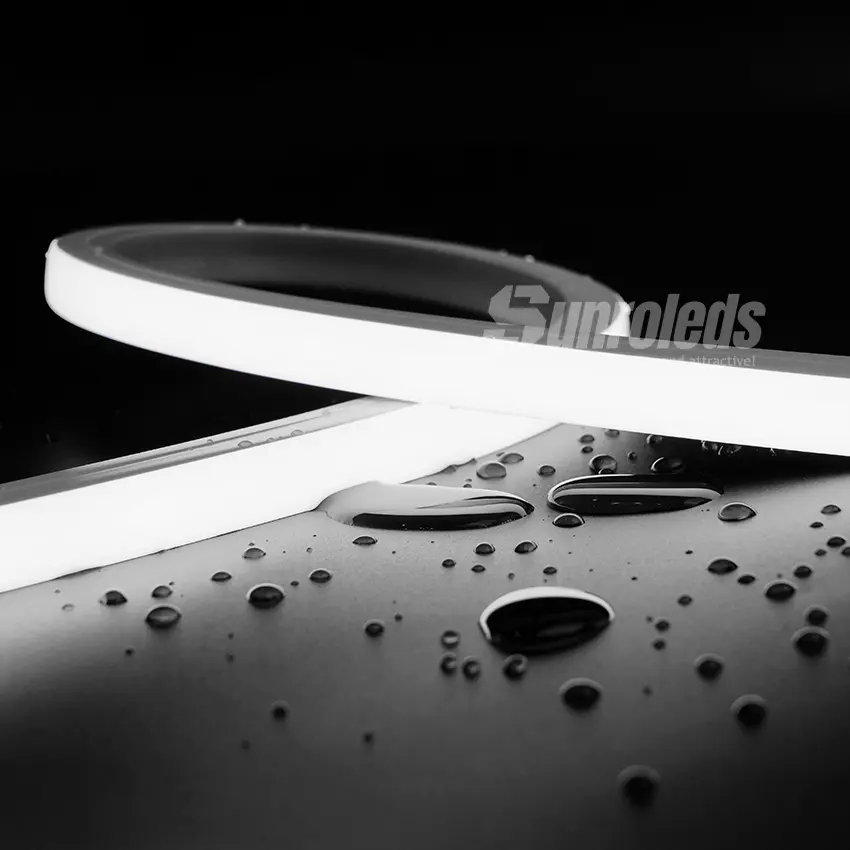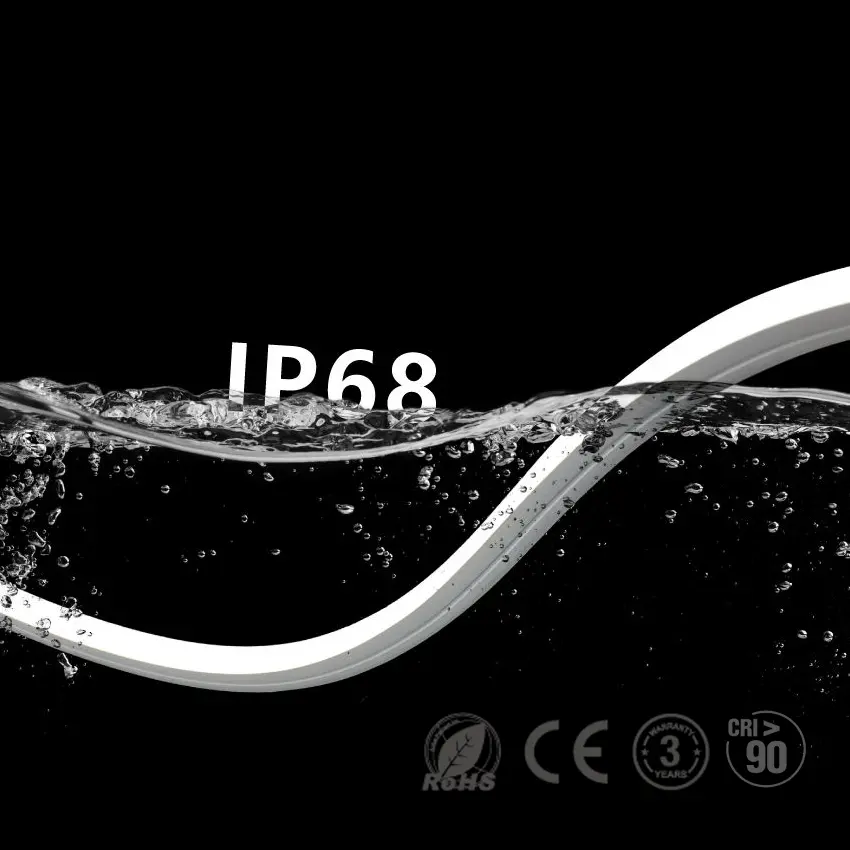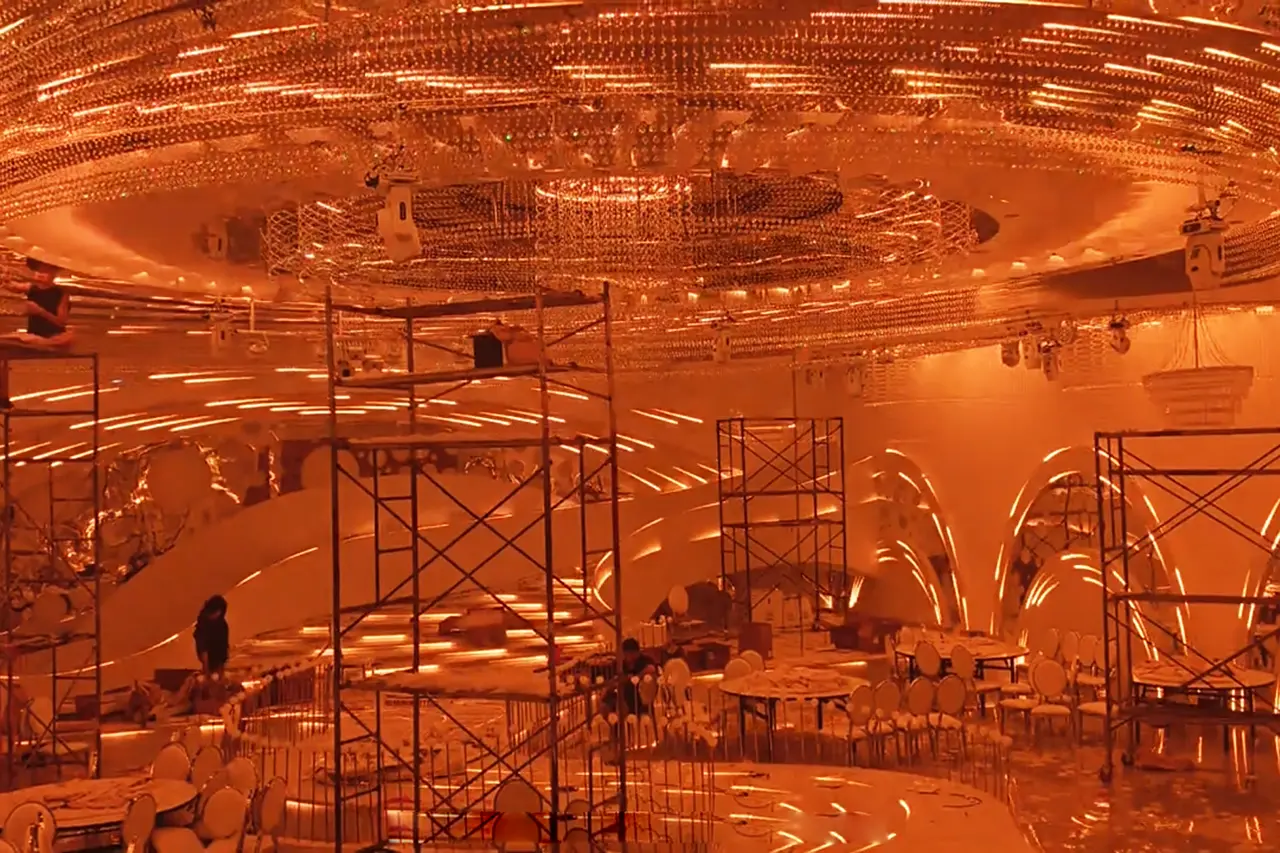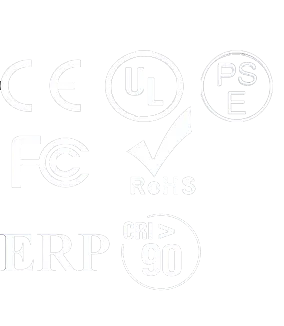
Top 5 LED Neon Light Materials Compared: Silicone vs. PVC vs. PU
When choosing the right material for your LED neon strip, it’s essential to consider not only performance but also longevity, flexibility, and cost. In today’s market, there are various materials used in LED neon strips, including PVC, silicone, Dow-Corning silicone, PU material, and composites silicone material. Each material brings its own set of advantages and disadvantages, which makes it crucial for businesses and designers to understand the differences when planning lighting projects.
This guide will compare the key materials used in LED neon strips and evaluate their strengths and weaknesses, helping you choose the best option for your specific needs, whether it’s for outdoor signage, architectural lighting, or indoor decorative applications.
Table of Contents
Manufacutring process
PVC (Polyvinyl Chloride)
PVC used in LED neon strips typically involves a manufacturing process known as hot melt injection molding. This method allows the material to be melted and injected into molds to form the desired shapes. For PVC LED neon strips, this process often results in hollow tubing, which houses the LED components inside.
Standard Silicone
The main component of standard silicone is silica, and it is manufactured through hot melt injection molding, resulting in solid tubing. This method ensures a robust and durable construction, enhancing the overall strength and longevity of the LED neon strip.
Dow-corning Silicone
Dow-Corning silicone is a specialized brand known for its high-performance formulations. It boasts superior light transmission and durability, making it an excellent option for applications requiring consistent brightness and color accuracy.
PU (Polyurethane) Material
The manufacturing process for PU involves mixing two liquid adhesive components (A+B), which then solidify into solid tubing. This liquid mixing and curing method ensures a seamless and durable product.
Silicone Composit material
Silicone composite material is a blend of silicone with other materials (such as fillers or reinforcements) to enhance specific properties while utilizing hollow tubing.
Light Transimission
Light transmission is a critical factor when it comes to LED neon lights, as it directly affects the brightness, color vibrancy, and overall aesthetic appeal of the illuminated space. Various materials used in manufacturing LED neon lights exhibit different levels of light transmission, influencing their performance in various applications. Below is a comparison of light transmission rates among several commonly used materials in LED neon lights: PVC, standard silicone, Dow-Corning silicone, PU material, and silicone composite materials.
PVC LED Neon Light
PVC is one of the most commonly used materials for LED neon lights, with a light transmission rate ranging from 50% to 60%. While PVC is cost-effective and easy to process, its relatively lower light transmission limits its brightness and effectiveness in applications requiring vivid lighting. Additionally, PVC is prone to yellowing over time, which can further diminish its light transmission and overall visual appeal.
Silicone LED Neon Light
Standard silicone offers a significant improvement in light transmission, with rates ranging from 60% to 70%. This enhancement contributes to a more vibrant lighting effect, making it suitable for various decorative and functional applications. Silicone’s durability and resistance to yellowing also extend the lifespan of the lighting, ensuring consistent performance over time. Its flexibility allows for creative designs, making standard silicone a popular choice for many users.
Dow-Corning Silicone LED Neon Light
Dow-Corning silicone takes light transmission to the next level, achieving rates between 70% and 80%. This advanced material not only enhances brightness but also ensures superior color rendering, making it ideal for settings where color accuracy is crucial, such as in retail displays or art installations. Its high resistance to environmental factors, including UV rays, means that the light output remains consistent over extended periods, maintaining both performance and aesthetic quality.
PU LED Neon Light
PU material stands out in terms of light transmission, with rates reaching up to 90%. This makes PU an exceptional choice for applications demanding maximum brightness and visual impact. In addition to its high light transmission, PU offers excellent flexibility and durability, which contributes to its versatility in various settings. Its resistance to wear and tear also ensures a longer lifespan, making PU neon lights a reliable investment for both indoor and outdoor installations.
LED Neon Tube (Silicone Composite)
Silicone composite materials are emerging as an innovative solution in the LED neon light market, combining the advantageous properties of silicone with additional composite materials. These light transmission rates depends on Supplier’s Formular.
Conclusion
| Material | Light Transimission Rated |
|---|---|
| PVC Material | 50%-60% |
| Standard Silicone | 60%-70% |
| Dow-corning Silicone | 70%-80% |
| PU Material | 80%-90% |
| Silicone Composite Material | Depends on Supplier Formular |
Flexibility and Strenth
When choosing LED neon strips, flexibility and strength are two critical factors, especially for projects that require intricate designs or installations in challenging environments.
PVC LED Neon Strip
PVC’s manufacturing process allows for the creation of a variety of shapes and designs and moderate strength, thanks to its hot melt injection molding method. While it is flexible in terms of production, PVC is relatively rigid compared to silicone or PU when it comes to practical use. It can bend to a certain extent, but its structural limitations make it less suitable for intricate or highly curved designs. Additionally, PVC tends to lose flexibility over time, particularly when exposed to extreme weather conditions, which can make it brittle and prone to cracking.
Silicone LED Neon Strip
Silicone is renowned for its exceptional flexibility, making it one of the best materials for projects that require complex shapes and curves. It can easily bend into tight corners and wrap around various structures without cracking or losing integrity. This makes it a preferred choice for both indoor and outdoor installations where precision and adaptability are crucial. Whether used in signage, architectural lighting, or decorative applications, silicone ensures smooth and hassle-free installations, even in challenging environments.
Dow-Corning LED Neon Strip
Dow-Corning silicone takes flexibility to another level. Known for its high-performance formulations, this material retains elasticity even under extreme conditions, withstanding temperatures from -40°F to 450°F (-40°C to 232°C). This high flexibility makes Dow-Corning LED neon strips ideal for high-end installations requiring precise and intricate designs. Whether used in architectural lighting, commercial displays, or outdoor settings, the material’s elasticity ensures that it holds up under stress without cracking or deforming.
Beyond its flexibility, Dow-Corning silicone offers superior strength and longevity. It maintains its structural integrity even after years of exposure to UV light, extreme temperatures, and environmental stressors. This makes it an excellent choice for long-term installations in both commercial and residential projects.
PU LED Neon Strips
PU LED neon strips are approximately 30% more flexible than standard silicone or PVC counterparts. This added flexibility allows for more creative and intricate designs without compromising the strip’s strength or durability. The elasticity of PU is particularly advantageous for applications that require frequent bending or movement, such as dynamic lighting displays, custom shapes, and complex architectural features.
Despite its superior flexibility, PU maintains excellent strength. It does not easily tear, break, or degrade, even when used in demanding environments. PU’s resilience and flexibility make it a go-to option for designers who need both adaptability and durability in their lighting solutions.
Conclusion
| Material | Flexibility Charater |
|---|---|
| PVC Material | Moderate flexibility in production; limited flexibility in use; prone to brittleness over time |
| Standard Silicone | Excellent flexibility; easily bends into complex shapes without cracking or losing integrity |
| Dow-corning Silicone | Superior flexibility and elasticity across a wide temperature range (-40°C to 232°C) |
| PU Material | 30% more flexible than standard silicone; excellent bending capabilities for intricate designs |
| Silicone Composite Material | Good flexibility; blends silicone with reinforcements for added strength and flexibility. |
Weather and Chemical Resistance
PVC LED Neon Strip: Basic Weather Resistance
PVC, though widely used due to its cost-effectiveness, offers only moderate protection against environmental factors such as rain and dust. While it can endure light weather exposure, its overall durability in harsh outdoor conditions is limited. UV exposure can cause the material to yellow and degrade faster, especially in regions with high sunlight. Its longevity is typically shorter than other materials, making PVC less ideal for demanding outdoor applications where long-term weather resistance is crucial.
Silicone LED Neon Strip: Excellent UV and Weather Resistance
Silicone stands out for its superior weather resistance, especially in outdoor applications. It offers excellent protection against UV rays, ensuring the material doesn’t yellow or degrade when exposed to sunlight. This characteristic makes silicone ideal for installations in areas with consistent sun exposure, such as outdoor signage or architectural lighting. In addition to UV resistance, silicone neon strips are highly resistant to extreme temperatures, ranging from -40°C to 200°C, making them suitable for environments that experience significant temperature fluctuations. The material’s natural waterproof properties also provide protection from rain and moisture, ensuring a longer lifespan even in harsh climates.
Dow-Corning Silicone LED Neon Strip: Premium Weather Performance
As a top-tier silicone material, Dow-Corning silicone provides exceptional weather resistance. Its ability to withstand extreme temperatures — from -40°C to 232°C — ensures that it remains flexible and performs reliably, whether in scorching heat or freezing cold. Additionally, its superior UV resistance ensures that the material retains its optical clarity and does not yellow, even after years of exposure to sunlight. This makes Dow-Corning silicone a premium choice for long-term outdoor installations where both durability and aesthetic consistency are essential. Its resilience in the face of prolonged environmental stress significantly extends the lifespan of the product, often surpassing 5 years.
PU LED Neon Strip: Superior Weather and Chemical Resistance
PU material excels in weather resistance, performing exceptionally well in outdoor environments. Its resistance to extreme temperatures can even exceed that of standard silicone in certain applications. PU LED neon strips are not only flexible but also highly durable, offering IP68 waterproofing, which provides complete protection against dust and water submersion. this makes PU an excellent choice for outdoor projects exposed to harsh weather conditions, such as heavy rain or snow, where both water resistance and flexibility are essential.
However, one limitation of PU is its natural vulnerability to UV light, which can cause degradation over time unless specially formulated with UV stabilizers. This makes standard PU less ideal for long-term outdoor exposure without proper UV treatment.
Silicone Composite Material : Enhanced Weather Durability
Silicone composite materials blend silicone with other reinforcing agents to enhance their durability and weather resistance. While maintaining the flexibility and UV protection of traditional silicone, composite materials often provide added strength and resistance to abrasion, corrosion, and other environmental factors. This combination allows silicone composite neon strips to perform well in diverse outdoor conditions, including high humidity, dust, and direct sunlight. The mixed properties also enhance their resilience to temperature extremes, ensuring stable performance in both hot and cold climates. As a result, silicone composite materials offer a robust solution for demanding installations that require both flexibility and heightened environmental protection.
Conclusion
| Comparision | Weather Resistance | Chemical Resistance |
|---|---|---|
| PVC Material | Moderate protection against rain and dust. Not ideal for long-term harsh outdoor use. Can degrade in extreme weather | Low resistance to oils, solvents, and chemicals. Can degrade with exposure |
| Ordinary Silicone | Excellent UV protection. Long-lasting durability in outdoor applications. Resistant to extreme temperatures. | Moderate resistance to chemicals. May degrade when exposed to strong solvents or oils |
| Dow-corning Silicone | Superior UV resistance and weathering stability. Performs well in extreme hot/cold climates. | Exellenct resistance to Salt resistance,Weak acide and alkali corrosion and Anti-chlorination |
| PU Material | Excellent in harsh weather conditions. Superior waterproofing (IP68) and resistant to extreme temperatures. | Good resistance to oils and solvents;Superior corrosion resistance, effectively withstands chlorine and other pool chemicals. Vulnerable to UV degradation |
| Silicone Composite Material | Good overall weather resistance with strong UV, water, and dust resistance. Suitable for outdoor applications. | Moderate chemical resistance, depending on the blend of materials used |
Temperature Resistance
PVC (Polyvinyl Chloride)
PVC has a relatively narrow temperature tolerance, typically functioning well in environments between -5°C to 60°C. While it can handle higher temperatures in some cases (up to 140°F or 60°C), PVC can become brittle and lose its physical properties in extreme conditions. This makes it unsuitable for applications requiring high or very low temperature resistance.
Ordinary Silicone
Silicone is renowned for its excellent temperature resistance, performing reliably in a range from -60°C to +250°C. Some high-temperature silicones can even withstand short-term exposure to temperatures as high as 300°C. Unlike other materials, silicone doesn’t melt under heat but remains solid until it reaches its auto-ignition point (around 450°C). This makes silicone ideal for applications requiring extreme temperature tolerance, such as kitchenware and industrial equipment.
Dow-Corning Silicone
Dow-Corning silicone, a high-performance type of silicone, offers a similar temperature range to standard silicone but with enhanced thermal stability and a higher heat tolerance limit. It can endure short-term exposure to temperatures up to 300°C while maintaining superior mechanical performance and durability over time, making it suitable for demanding industrial applications;
PU (Polyurethane) Material
PU material generally withstands temperatures from -40°C to +80°C, although special formulations can endure temperatures as high as 120°C. While PU retains excellent flexibility at low temperatures, it may degrade when exposed to high heat, making it unsuitable for long-term use in extreme heat environments.
Silicone Composite Materials
Silicone composite materials combine silicone with other components to enhance mechanical and thermal properties. These composites are often designed to handle a broader temperature range, typically -60°C to +250°C, or even higher depending on the fillers and reinforcements used.
Conclusion
| Comparision | Temperature Resistance |
|---|---|
| PVC Material | Limited temperature range; unsuitable for extreme conditions; |
| Ordinary Silicone | Exceptional performance; ideal for high and low extremes; |
| Dow-corning Silicone | Superior thermal stability and mechanical durability; |
| PU Material | Good for low temperatures but limited heat resistance; |
| Silicone Composite Material | Can offer excellent heat tolerance depending on formulation; |
Waterproof Performance
PVC LED Flex Neon
PVC offers moderate waterproofing capabilities, but it is typically suited for environments that are not in direct contact with water. Its waterproof performance largely depends on the thickness of the material and the quality of its sealing. Often, additional waterproof coatings or sealants are required to enhance its waterproofing properties. However, PVC may degrade or become brittle when exposed to prolonged immersion or extreme humidity, making it unsuitable for applications that demand a high waterproof rating.
Ordinary Silicone LED Flex Neon
Silicone is well-known for its superior waterproofing abilities, commonly achieving protection levels of IP65 or higher. It provides effective moisture resistance and performs exceptionally well in high-humidity environments. The flexibility and durability of silicone make it an ideal choice for sealing and insulating applications, especially in settings that require resistance to moisture and chemical corrosion.
Dow-Corning Silicone LED Flex Neon
Dow-Corning silicone, a high-performance variant, exceeds standard silicone in waterproofing capabilities, typically reaching IP67 or higher. This means it can withstand short-term immersion in water (up to 1 meter deep) while maintaining its functionality in harsh conditions. With excellent weather and chemical resistance, Dow-Corning silicone is ideal for demanding industrial applications.
PU LED Flex Neon
PU material excels in waterproof performance, often achieving the IP68 rating, meaning it can endure long-term immersion in water at depths 5 meter, making it suitable for underwater or outdoor environments. Due to its smaller molecular gaps, PU effectively prevents water penetration, performing well in wet or submerged conditions. Additionally, PU provides excellent resistance to UV rays, acid rain, and other chemical substances, allowing it to remain stable in a variety of environments.
Silicone Composite Neon Tube
Silicone composite materials, which combine silicone with other fillers or reinforcements, typically offer outstanding waterproofing properties. These composite materials can be engineered to enhance their waterproof capabilities, making them suitable for demanding sealing and insulation applications. Depending on the specific formulation, these materials can achieve IP67 ratings.
Conclusion
| Comparision | Waterproof Level | Characteristics | Best Use |
|---|---|---|---|
| PVC Material | Moderate IP65 Rated | Requires additional coatings or sealants for enhanced waterproofing. Degrades in prolonged immersion or high humidity. | Non-direct water contact environments |
| Ordinary Silicone | IP65 or higher | Excellent moisture resistance, performs well in humid conditions. Flexible and durable | Sealing and insulating in high-humidity or chemical-resistant environments. |
| Dow-corning Silicone | IP67 or higher | Superior waterproofing, can handle short-term immersion (up to 1 meter). High resistance to weather and chemicals; | Outdoor Applications needing strong waterproofing and durability. |
| PU Material | IP67 / IP68 | Excellent for long-term water immersion. High resistance to UV rays, chemicals, and harsh environments; | Outdoor and submerged applications, such as underwater lighting or outdoor signage |
| Silicone Composite Material | IP67 (varies by formulation) | Engineered for enhanced waterproofing, flexible and durable; | High-demand sealing and insulation applications requiring Indoor & Outdoor waterproofing. |
Physical durability and toughness
When selecting materials for industrial, architectural, or commercial applications, physical durability and toughness are key considerations. These properties determine how well a material can withstand mechanical stress, environmental conditions, and the wear and tear of everyday use. Different materials excel in different areas, depending on their inherent properties and composition
PVC LED Neon Lights
PVC is a widely used plastic known for its excellent physical durability. It boasts strong oxidation resistance and can endure exposure to environmental factors, allowing it to last over 100 years under normal conditions. PVC offers good compressive and tensile strength, making it suitable for applications like construction and plumbing. However, one limitation of PVC is its tendency to become brittle in low-temperature environments, making it prone to cracking or breakage under extreme cold. Therefore, it requires careful consideration for use in such climates;
Ordinary Silicone LED Neon Lights
Silicone is well-known for its elasticity and durability, maintaining performance between -60°C and +250°C. It has excellent tear and abrasion resistance, making it ideal for applications like medical devices, kitchenware, and electronics. However, a key limitation of standard silicone is its inability to bend at sharp angles without damage. While it can endure minor flexing and stretching, bending silicone at extreme angles could cause it to tear over time. This makes standard silicone more suitable for applications requiring moderate flexibility rather than sharp, repeated bending.
Dow-Corning Silicone LED Neon Lights
Dow-Corning silicone, a high-performance version of standard silicone, offers enhanced physical durability. It retains strong elasticity but has better resistance to heat and chemicals. This material maintains flexibility over long periods, even under demanding conditions, and can bend more sharply without risk of tearing, compared to standard silicone. Its higher tear strength and aging stability make it ideal for industrial applications requiring both flexibility and toughness in extreme conditions.
PU LED Neon Lights
Polyurethane is known for its toughness and elasticity, excelling in absorbing impacts. PU has outstanding wear resistance, suitable for high-durability applications like automotive parts, seals, and industrial flooring. It retains flexibility at low temperatures and can bend at sharper angles without compromising integrity, compared to silicone. However, in high-temperature environments, PU can degrade, so it may not be ideal for applications exposed to continuous heat.
Silicone Composite Neon Tube
Silicone composite materials combine silicone with reinforcing elements for enhanced physical durability. These composites are engineered to provide greater tear and abrasion resistance than standard silicone. They offer better flexibility, it has limitation to flexible angle incase of damage, they are also ideal for industrial seals, gaskets, and insulation where both strength and flexibility are essential. The performance varies based on the specific formulation, allowing for a wide range of industrial uses.
Conclusion
| Comparision | Durability | Flexibility | Toughness |
|---|---|---|---|
| PVC Material | Excellent oxidation resistance; lasts 100+ years | Limited in extreme cold; may become brittle | High tensile and compressive strength |
| Ordinary Silicone | Good tear and abrasion resistance | Limited sharp bending; flexible at moderate angles | Moderate toughness, prone to tearing under sharp bends |
| Dow-corning Silicone | Superior heat, chemical, and tear resistance | Better flexibility, tolerates sharper bends than standard silicone | Higher tear strength and aging stability |
| PU Material | Excellent wear and impact resistance | 30% more flexible than silicone. it help create different shape | High toughness, but degrades in high heat |
| Silicone Composite Material | Enhanced durability due to reinforcement | Limited sharp bending; flexible at moderate angles | Very high toughness, varies by formulation |
Application Comparision
When selecting materials for industrial, architectural, or commercial applications, physical durability and toughness are key considerations. These properties determine how well a material can withstand mechanical stress, environmental conditions, and the wear and tear of everyday use. Different materials excel in different areas, depending on their inherent properties and composition
PVC LED Neon Rope Light
PVC LED neon rope light are the most cost-effective option, making them ideal for budget-conscious projects and indoor applications where extreme environmental factors are not present. Due to their moderate flexibility and basic weather resistance, they are often used in signage, commercial displays, or indoor decorative lighting. However, PVC’s limitations in high temperatures and exposure to UV light make it unsuitable for outdoor or harsh environments, where long-term durability is a concern.
Best for: Indoor signage, commercial displays, decorative lighting.
Silicone LED Neon rope light
Silicone offers excellent flexibility and durability, making it a top choice for both indoor and outdoor applications. Its ability to withstand a wide temperature range (-60°C to +250°C) makes silicone LED neon lights perfect for architectural lighting, facade decoration, and outdoor events. Additionally, silicone’s UV resistance ensures it won’t yellow under prolonged sun exposure, and its waterproof qualities (IP65 or higher) make it suitable for humid or wet environments such as bathrooms or gardens.
Best for: Indoor& Outdoor architectural lighting, landscape lighting, signage in humid environments.
Dow-Corning Silicone LED Neon rope Light
Dow-Corning silicone, as a premium material, provides superior performance in extreme conditions. It is highly resistant to UV light, extreme temperatures, and chemical exposure, making it ideal for demanding industrial applications or high-end outdoor installations. This material is often used in outdoor architectural lighting for high-rise buildings, bridges, and waterfront installations where reliability, longevity, and appearance are critical. Its strong resistance to weathering and yellowing ensures performance over many years.
Best for: High-end indoor and outdoor lighting projects, industrial installations, areas with extreme weather or chemical exposure.
PU LED Neon rope Light
PU (Polyurethane) LED neon strips offer excellent flexibility and are known for their high water resistance (IP68), making them suitable for submersion or near-water applications like fountains, swimming pools, or coastal environments. Additionally, PU’s exceptional chemical resistance makes it a great choice for environments exposed to chemicals, oils, or solvents. Its superior durability ensures it performs well in industrial settings such as garages, workshops, or areas prone to chemical spills.
Best for: indoor Lighting project; Submersible lighting, swimming pools, fountains, chemical and industrial environments.
Conclusion
| Comparision | Application |
|---|---|
| PVC Material | Indoor lighting, commercial signage, cost-effective decorative installations. |
| Ordinary Silicone | Indoor and Outdoor architectural and landscape lighting, garden installations, wet or humid environments. |
| Dow-corning Silicone | High-end outdoor installations, industrial lighting, projects in extreme weather or chemical-rich environments; |
| PU Material | Submersible lighting (swimming pools, fountains, underwater), chemical and industrial environments, outdoor areas with limited UV exposure, High-demanded flexible design project |
| Silicone Composite Material | Indoor and Outdoor architectural and landscape lighting, garden installations |
Cost Comparision
When comparing the maintenance costs of PVC LED neon strips, silicone LED neon lights, Dow-Corning silicone LED neon lights, and PU LED neon lights, the material properties and lifespan of each significantly impact maintenance needs and expenses.
PVC LED Neon Lighting
- Costs: The costs of PVC LED neon strips are relatively low, mainly due to their simple structure and durability. However, PVC’s resistance to weathering is limited, so regular inspections may be required to ensure no aging or damage.
- Lifespan: PVC LED neon lights typically have a lifespan of around 30,000 hours. While replacement is not frequent, more frequent inspections and maintenance may be necessary in extreme environments.
- Total Maintenance Expenses: Over a 10-year usage cycle, annual maintenance costs are expected to be low, primarily focused on cleaning and occasional replacements.
Silicone LED Neon lighting
- Costs: the silicone cost is higher than PVC Material. but it also have relatively low maintenance costs. Thanks to their excellent waterproofing and UV resistance, they generally do not require frequent maintenance.
- Lifespan: Silicone LED neon lights can last over 50,000 hours, reducing the need for frequent replacements.
- Total Maintenance Expenses: Over a 10-year period, maintenance costs mainly involve regular inspections and cleaning, making the overall cost economical.
Dow-Corning Silicone LED Neon Lighting
- Costs: Dow-Corning silicone cost is much more expensive than ordinary silicone’s. Their high resistance to weathering and chemicals allows them to perform excellently in harsh environments.
- Lifespan: These lights have a lifespan of up to 100,000 hours, meaning they require minimal maintenance over time.
- Total Maintenance Expenses: Despite the higher initial investment, the long lifespan and low maintenance needs result in relatively low total maintenance expenses over a 10-year period.
PU LED Neon rope Light
- Costs: The cost is much more expensive than silicone. but it have very low maintenance costs due to their superior waterproofing and durability. They are resistant to environmental factors and therefore require little to no regular maintenance.
- Lifespan: PU LED neon lights typically last over 50,000 hours, which significantly reduces replacement frequency.
- Total Maintenance Expenses: Over a 10-year period, the low maintenance demands and durability result in extremely economical overall costs.
Conclusion
| Comparision | Cost |
|---|---|
| PVC Material | Low initial investment but require periodic inspections, with overall moderate maintenance costs; |
| Ordinary Silicone | Higher Cost than PVC’s , low maintenance needs, resulting in economical overall costs. |
| Dow-corning Silicone | Much more expensive than Silicone’s,High-performance material with higher initial investment, but long-term maintenance costs are low |
| PU Material | Much more expensive than Silicone’s, Excellent durability and waterproofing make them nearly maintenance-free, resulting in the lowest overall costs |
| Silicone Composite Material | Higher Cost than PVC’s , low maintenance needs, resulting in economical overall costs |
Summary of LED Neon Lights
Based on the comparison of the various performance characteristics such as waterproofing, weather resistance, flexibility, applications, and price for PVC LED neon strips, silicone LED neon lights, Dow-Corning silicone LED neon lights, and PU LED neon lights, here’s a comprehensive summary that includes the pros and cons of each material, helping to identify which might be considered the best option depending on specific needs.
PVC LED Neon Light
- Advantages:
- Cost-Effective: PVC is the most affordable material used in LED neon strips, making it an excellent choice for budget-conscious projects.
- Easy to Mold: PVC’s flexibility in manufacturing allows for various shapes and designs, although it’s not as flexible in use as silicone.
- Basic Weather Resistance: While not as strong as silicone or PU, PVC offers moderate protection against environmental factors like rain and dust.
Disadvantages:
- Lower Transparency: PVC materials have a lower light transmission rate, typically around 50-60%, leading to less efficient light diffusion compared to silicone.
- Limited Durability: PVC is prone to yellowing and degrading when exposed to UV rays, leading to a shorter lifespan of around 1-2 years.
- Less Flexibility: PVC doesn’t handle sharp bends as well as silicone or PU, making it less suitable for complex installations requiring intricate shapes.
- Not Ideal for Harsh Environments: PVC is not recommended for long-term outdoor applications as it may deteriorate quickly when exposed to harsh weather conditions.
Silicone LED Neon Light
Advantages:
- Durability and Flexibility: Silicone is known for its excellent flexibility and resistance to extreme temperatures, making it ideal for both indoor and outdoor applications. It can easily bend into complex shapes without cracking, ensuring smooth installations even in difficult spaces.
- UV Resistance: Silicone provides strong UV protection, ensuring it won’t yellow or degrade quickly when exposed to sunlight, which is important for outdoor lighting projects.
- Waterproof: Silicone neon strips are typically rated IP67 or IP68, offering high waterproof protection, suitable for areas prone to rain or near water sources like fountains or pools.
- Long Lifespan: Due to its high resistance to environmental factors, silicone lasts longer than many alternatives, often achieving 3 to 5 years or more.
Disadvantages:
- Cost: Compared to PVC, silicone tends to be more expensive due to its superior performance.
- Brittleness in High Bend Angles: In cases where extreme bends are required, silicone can be prone to cracking or breaking, especially over time.
- High-Temperature Risks: During production, the heat required for molding silicone (up to 250°C) can potentially damage LED chips or circuit solder points.
Dow Corning Silicone LED Neon Light
Advantages:
- Premium Optical Clarity: Dow-Corning silicone provides unmatched transparency, with light transmission rates exceeding 90%. This ensures that LED neon strips deliver bright, clear, and vibrant light, enhancing their visual appeal.
- Exceptional UV Resistance: Designed for outdoor use, Dow-Corning silicone maintains its color and integrity even after prolonged exposure to sunlight, preventing yellowing and extending the lifespan of the product.
- Long-Term Durability: With superior resistance to weathering, Dow-Corning silicone-based LED neon strips can last 5 years or longer, making them a preferred choice for high-end installations.
- High Thermal Stability: This premium material can withstand extreme temperature variations, ensuring consistent performance in both hot and cold climates.
Disadvantages:
- High Cost: As a premium material, Dow-Corning silicone is more expensive than standard silicone, PU, or PVC, which may limit its use in budget-sensitive projects.
- Brittleness in High Bend Angles: In cases where extreme bends are required, silicone can be prone to cracking or breaking, especially over time.
- High-Temperature Risks: During production, the heat required for molding silicone (up to 250°C) can potentially damage LED chips or circuit solder points.
PU LED Neon Light
Advantages:
- Increased Light Transmittance: 20% improvement over silicone, enhancing illumination quality.
- Enhanced Flexibility: 30% more flexible, allowing for more creative designs without compromising durability.
- Superior Hand Feel: Improved texture and quality perception.
- Enhanced Chemical Resistance: PU performs well in environments with exposure to chemicals, offering better resistance to acids and corrosion than PVC or standard silicone.
- Better Waterproofing: Achieves IP68 rating, surpassing IP67, ensuring superior protection against water ingress.
- Stable Color Temperature Control: Liquid molding ensures uniform color distribution and consistency.
- No High Temperature Processing: Avoids additional heat exposure that can harm the LED components, ensuring longevity and performance.
Disadvantages:
- Cost: Although cheaper than Dow-Corning silicone, PU is still more expensive than standard silicone and PVC.
- UV Vulnerability: While PU is highly resistant to wear, it does not perform as well as silicone when exposed to prolonged UV radiation, which may cause degradation over time.
Silicone LED Neon Tube
Advantages:
- Strong Weather Resistance: Mixed silicone typically has excellent UV resistance, water resistance, and dustproof properties, making it suitable for outdoor use.
- Good Flexibility: It can be easily bent into various shapes, making it ideal for complex designs and installation requirements.
- High-Temperature Resistance: It can operate stably in high-temperature environments, reducing the risk of damage due to temperature fluctuations.
- High Durability: Compared to pure silicone, mixed materials usually offer better abrasion and corrosion resistance, extending the lifespan.
- Light Transmittance: Depending on the formulation, mixed silicone can improve light transmittance while maintaining good flexibility.
Disadvantages:
- Higher Cost: The production cost of mixed silicone may be higher than that of PVC and other materials, impacting the budget.
- Processing Difficulty: Some mixed materials may require more complex processes during fabrication and molding.
- Performance Consistency: Variations in formulations from different manufacturers may lead to inconsistent performance, necessitating careful selection.
- Chemical Resistance: While mixed silicone generally performs well, it may not have the same level of resistance to certain specific chemicals as specialized chemical-resistant materials.
Conclusion
The “best” choice ultimately depends on specific application needs:
- For Budget-Conscious Buyers: PVC LED neon strips are the most economical option but may not perform well in outdoor or extreme conditions.
- For General Indoor and Outdoor Use: Silicone LED neon lights strike a balance between cost and performance, making them suitable for most applications while providing excellent durability and waterproofing.
- For Industrial and Harsh Environments: Dow-Corning silicone LED neon lights are ideal for demanding applications, offering the best performance and longevity, albeit at a higher initial cost.
- For Extreme Waterproof Requirements: PU LED neon lights provide the best waterproofing and flexibility, making them suitable for unique applications such as underwater lighting.
In summary, each material has its own strengths and weaknesses. The best choice depends on the specific requirements of the project, including budget, environmental conditions, and performance expectations. By evaluating these factors, consumers can select the most appropriate LED neon lighting solution for their needs.
Share this article
Written by : Sophia Ng
Hey there! This is Sophia Ng, Worked for Sunroleds with 15 years in the industry, specializing in sales and marketing.
I'm committed to excellence and always aim to exceed expectations. Outside of work, I enjoy traveling and exploring traditional Chinese culture.
Let's connect and make some magic happen!




